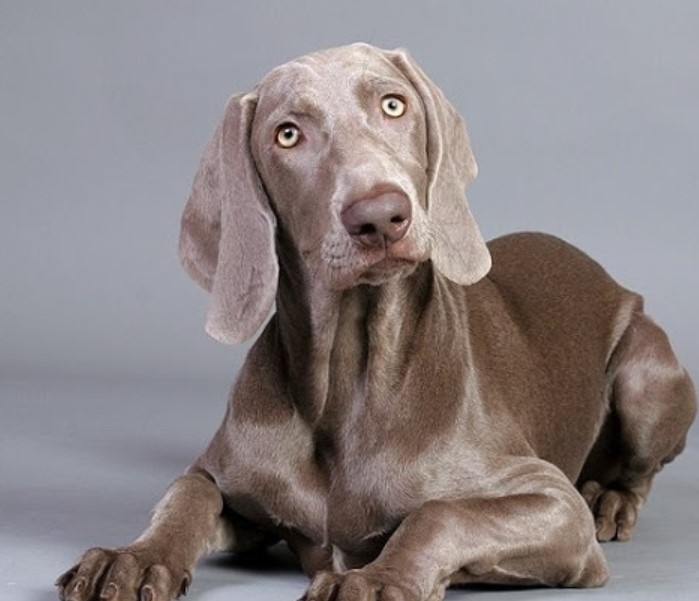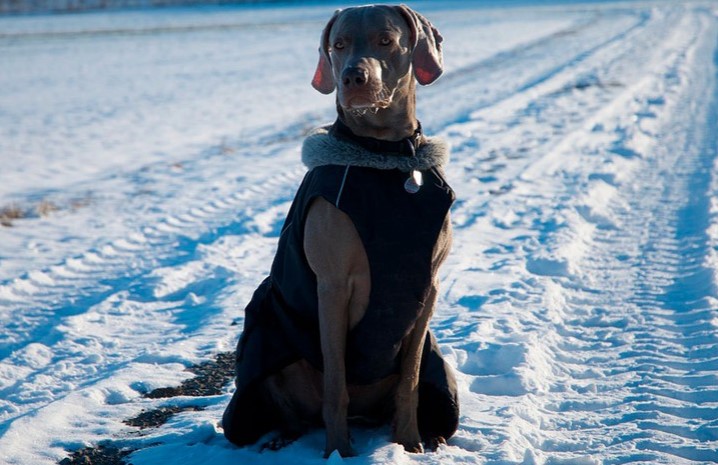
The graceful and fast-paced “gray ghost” of Germany, of royal descent, is loved by hunters and pet owners for their friendliness, obedience, and beauty. The Weimaraner is a very proud dog, but obedient and easy to train.
It is a hunting dog, but in some countries (for example, in Brazil), due to its excellent sense of smell, it is used in the police service, as well as a rescue and search dog. The very good character of this Pointing Dog makes it a truly versatile dog. When hunting, the Weimaraner is stubborn and methodical in his quest.
Possessing an inexhaustible supply of energy and amazing endurance, the Weimaraner is perfect for a person who leads an active lifestyle. This is an excellent companion, devoted to its owner and ready to spend all his time with him.
Personality
The “Gray Ghost,” as the Weimaraner is called because of the color of its coat in the United States, is an excellent working and domestic dog, very attached to its family. This dog loves to play, which can be successfully used in her training and strengthening relations with the owner. Try not to use the ball or stick chase during games, as this enhances the Weimaraner’s hunting instinct. Unless you plan to use your dog for hunting, these games should be avoided.
If the Weimaraner has the opportunity to regularly spend huge reserves of energy, he will behave very calmly in the house, resting in his basket or on the sofa, as he loves comfort. But if this dog lingers within the four walls, during a walk it will start letting off steam with such enthusiasm that it can hardly be stopped.
The versatility of this hunting dog is due to its amazing intelligence. The Weimaraner is balanced, obedient, sensitive, and easily adapts to any lifestyle. The purposeful nature of the Weimaraner helps him a lot during the hunt, making him a methodical and persistent tracker.
Due to its elegant and proud appearance, this dog can give the impression of a very independent dog, but this does not correspond to its nature at all. Weimaraner is very close to his social group and values it more than anything else. He hates loneliness, he needs to take part in everything that happens in the life of the owners. However, while working, this dog is able to act independently and make independent decisions.
As soon as a Weimaraner puppy appears in your home, you must immediately begin to accustom him to your absence. This should be done gradually, gradually increasing the time during which he is alone. This dog can be very destructive if left alone for long hours without any activity. This is especially true for Weimaraner puppies, which are very restless and energized.
Breed Standards
- Height: from 57 to 70 cm
- Weight: 25 to 40 kg
Weimaraner – a dog larger than average, the exterior maximally contributes to the disclosure of working qualities. A dog of balanced temperament, with excellent instinct, strong character, hardy. The movements are free and smooth. The skin is not too tight, but not saggy.
The head is proportional to the body. The skull is not narrow. The furrow in the middle of the forehead is pronounced. The occipital protuberance is slightly protruding. The cheekbones are clearly visible. The head is dry, but the muscles around the cheeks are well defined. The transition from the forehead to the muzzle is smooth and poorly expressed. The muzzle is longer than the cranial part of the head, deep. The bridge of the nose can be either straight or with a hump. The nose protrudes beyond the front of the jaws. Liver color, turning to gray towards the muzzle. The lips are slightly saggy, forming small folds in the corners. They have a liver color. The jaws are powerful, teeth free from plaque and disease, a complete set. The bite is correct. The eyes are set somewhat obliquely, the eyes themselves are round. The color is amber, both dark and light. The eyelids show no signs of dampness. The ears are set high, drooping, reaching the corners of the mouth in length. Wide. Located close to each other. The lower edge of the ear is rounded. In an alert dog, the ears turn slightly forward, forming a fold.
The neck is of medium length or slightly longer, with developed muscles. Has noble lines. The upper line is somewhat curved. No signs of dampness. Round in cross-section, wider at the body than at the head. The transition to the line of the back and chest is smooth. Withers pronounced. The back is strong, strong, without sagging and humps. The loin is well-muscled, of the correct shape. The croup is rather long and somewhat sloping.
The tail is low set, long, rather wide, with a good coat. Hanging alone. When working, it can reach the horizontal line and even rise above it. The chest is not too deep and wide, but long and powerful. The belly is not pulled in, but not saggy either.
The legs are long, sinewy, without curvature, parallel to each other, strong, and muscular. The joints are strong and tight. The forelegs are closely spaced. Hare paws, regular shape.
According to the length of the coat, Weimaraners are divided into short-haired and long-haired. The short-haired has a very dense, well-fitting, relatively long (compared to other short-haired breeds) single coat. The long-haired have double hair, but it can also be single. The outer hair is soft, smooth, or somewhat wavy. Length 3-5 centimeters, longer hair at the base of the ears, along the bottom of the neck, front of the chest, and abdomen. The hair on the head and ears is shorter.
Colors – practically all shades of gray, except very dark ones. The head and ears are usually somewhat lighter than the general background. A “strap” along the back of a slightly darker shade is also possible. Very slight white markings on the chest and toes are acceptable.
Care
The short and dense coat of this hunting dog does not need frequent and difficult grooming. A weekly brushing will be enough to preserve its rare beauty.
Weimaraner’s seasonal molts are moderate and require cleaning the dog several times a week. For successful fur control, get a special glove and a good vacuum cleaner. Wash the Weimaraner as needed. The dog’s eyes and ears should be monitored and cleaned regularly to avoid infection.
Health
Like other deep-chested dogs, Weimaraners are susceptible to dilatation — twisting of the stomach, also known as bloating. In this state, the stomach fills with air and food, and then turns over, making it impossible to empty and creating a life-threatening situation. Avoid exercise for 1–2 hours before and after meals and feed your dog from floor level, not from a stand.
Frequent illnesses:
- dysplasia of the hip and elbow joints
- renal dysplasia
- umbilical hernia
- skin problems (cutaneous asthenia)
- distichiasis/trichiasis (eyelash growth abnormalities)
- Wobbler’s syndrome (compression of the spinal cord in the neck)
- epithelial corneal degeneration
- tumors (mastocytoma, lipoma, etc.)
History of the Breed
Bred in the early 1800s, the Weimaraner is one of the most beautiful dog breeds around. The key figure in the emergence of this dog was the Grand Duke of Germany Karl August, who lived in the city of Weimar. The Duke, like many European nobles of the time, was an avid hunter. His dream was to breed the perfect hunting dog and in pursuit of this desire, he crossed Bloodhounds with various German and French hunting dogs. The result of that experiment was the Weimaraner.
Initially, the Duke and other noblemen used these unique-looking dogs to hunt big game such as bears, mountain lions, and wolves. When the population of these predators in Europe greatly decreased, the Weimaraner found a new job as a universal hunter, who searches for and brings small game: foxes, hares, and birds.
Over time, the breed gained popularity outside of Germany. The American Weimaraner Club was founded in 1929 after a breeder named Howard Knight imported a pair of fine Weimaraners into the country. The Weimaraner gained its greatest popularity in the 1950s after becoming the pet of famous personalities such as President Eisenhower and movie star Grace Kelly.
Today, the breed is experiencing a second surge in popularity, thanks to the work of the photographer and artist William Wegman, who himself became famous for his portraits of Weimaraners.






